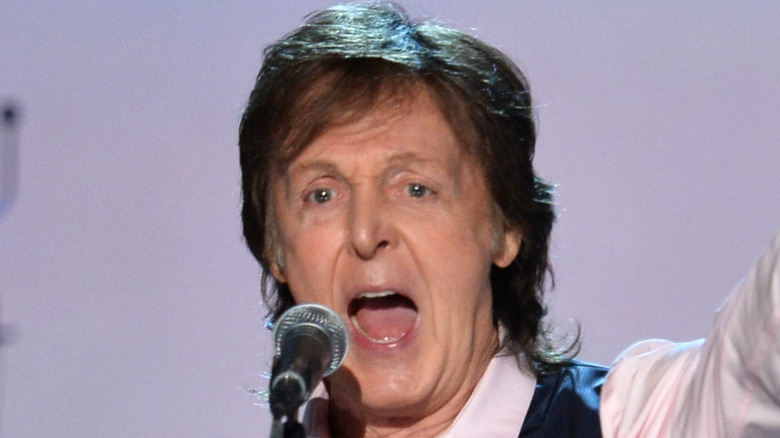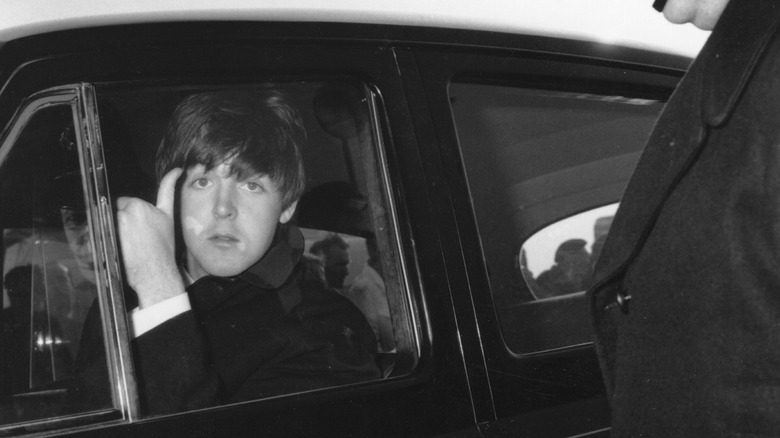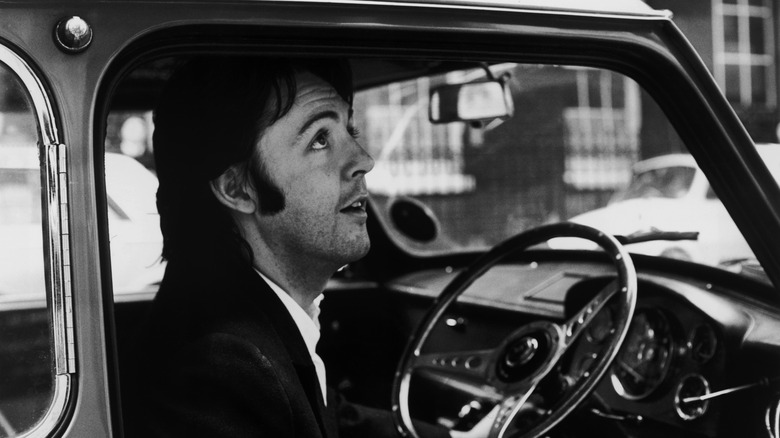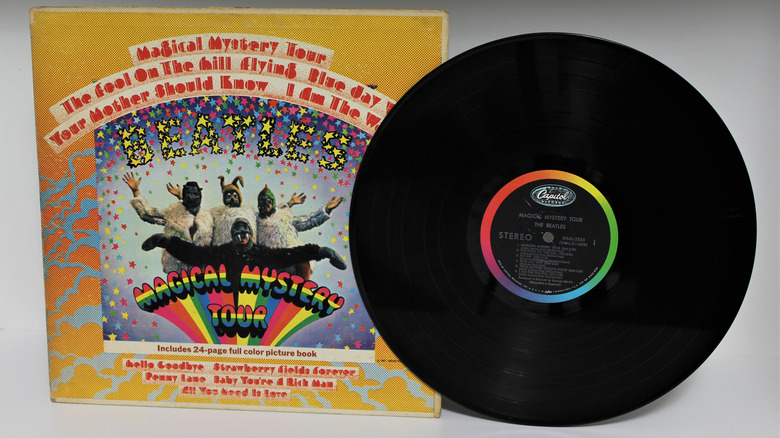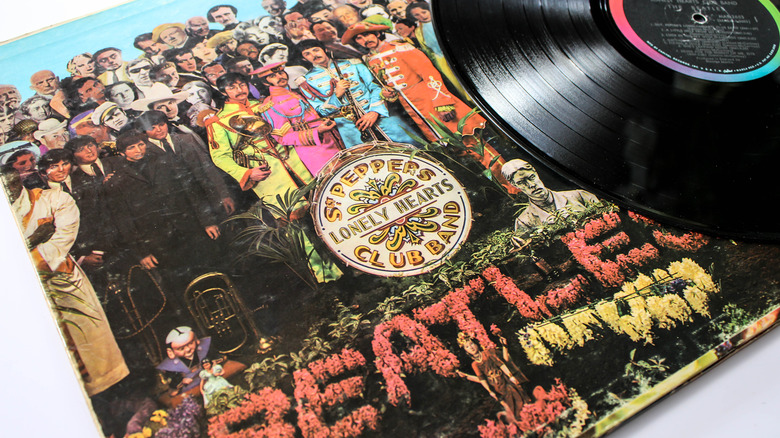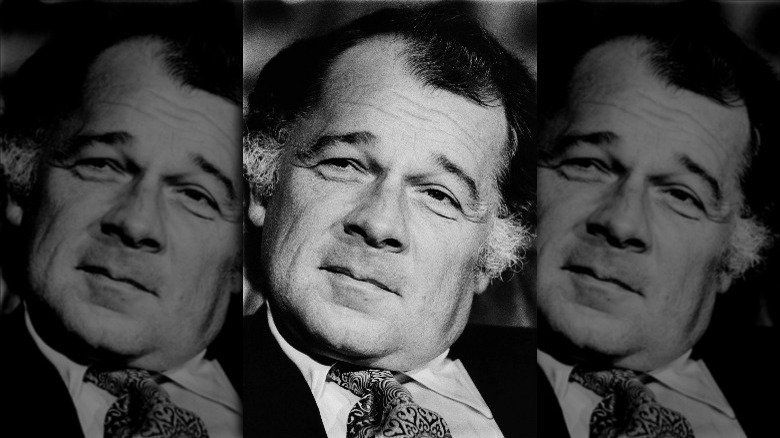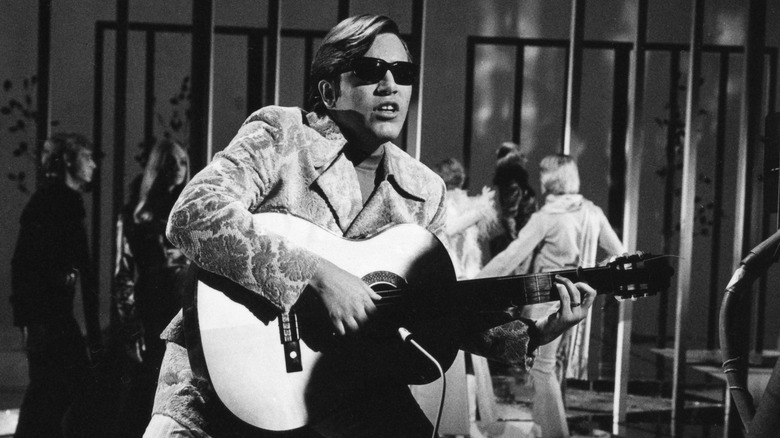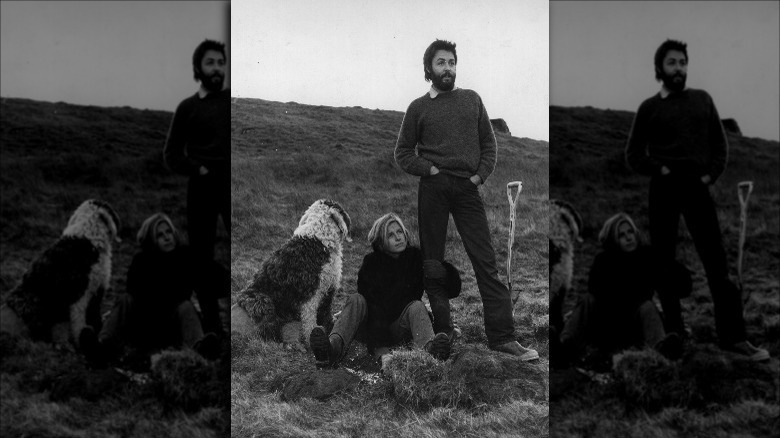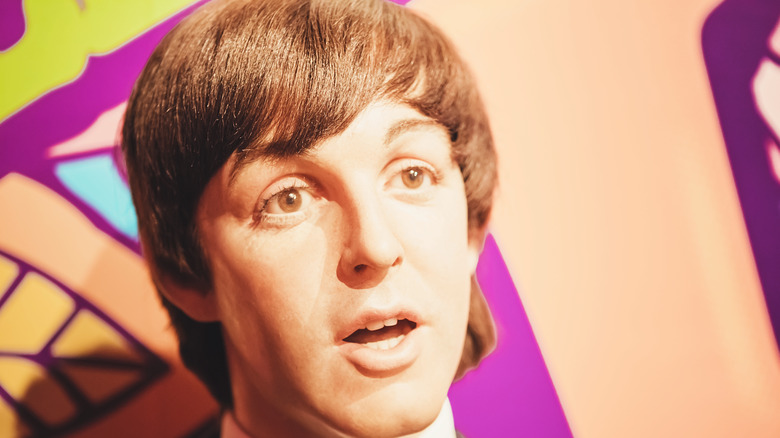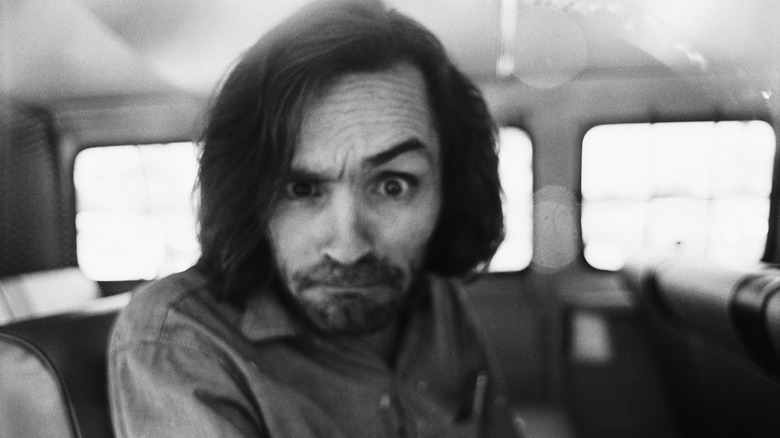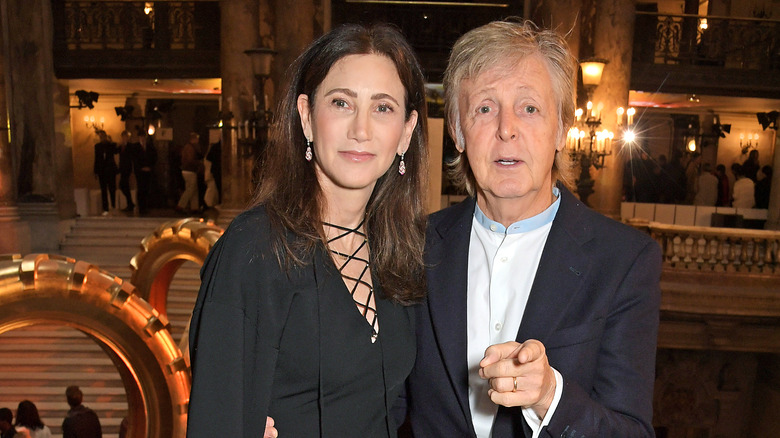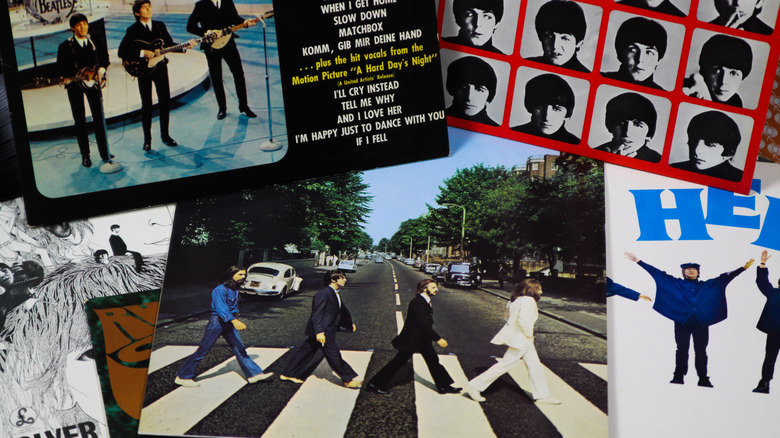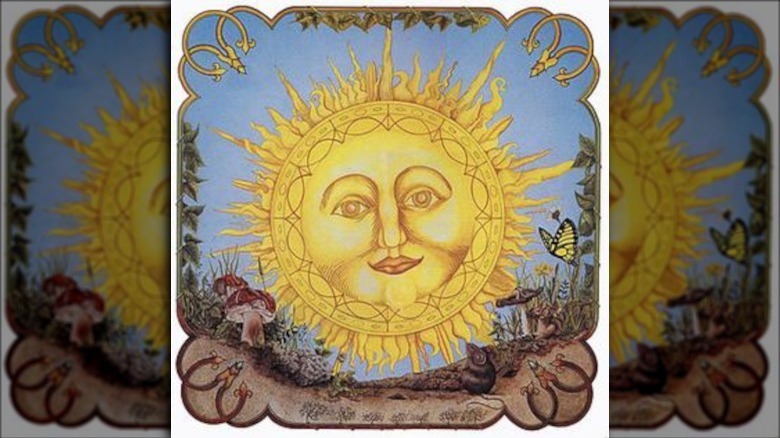The Bizarre Fan Theory Claiming Paul McCartney Is Dead
There's a rich tradition of conspiracy theorying in popular music. Depending on who you ask, you might be surprised to learn that Stevie Wonder can see perfectly well, that Jay-Z and Beyonce are definitely members of the Illuminati, or that Lorde is actually a middle-aged woman in her 40s masquerading as a millennial.
Some of the best conspiracy theories concern celebrities that are either actually dead, dead and replaced by lookalikes, or not quite as dead as you've been led to believe. Avril Lavigne, for example, was apparently replaced by a clone years ago (which explains so, so much). And Elvis, of course, faked his own death back in the 1970s in order to live a normal life, possibly as an underappreciated Elvis Impersonator.
All of these conspiracy theories owe a debt to the granddaddy of them all: Paul Is Dead. Before the Internet, before Photoshop, before disco, one of the most famous musicians on the planet found himself embroiled in one of the most bizarre, complex, and downright fascinating stories of all time. It's got it all: death, lookalikes, purposefully leaked clues, and a mythology that has withstood the test of time. Jump down into this rabbit hole to explore the bizarre fan theory claiming Paul McCartney is dead.
It all began in January 1967
The crazy thing about crazy conspiracy theories is that there's usually some small pebble of truth somewhere in there. That's what allows folks to latch on and go all-in, because once you can prove one tiny piece of it to be absolutely true, it's easy to believe the rest of it might be as well.
That's how Paul Is Dead got it's start. Radio X reports that in January 1967, The Beatles' official fan magazine, Beatles Monthly Book, reported a rumor about Paul McCartney dying in a car crash on wet roads on the M1 late in 1966. Of course that wasn't true — but as All That's Interesting notes, McCartney had been in a motorbike accident. And someone who wasn't McCartney actually did borrow and then crash his car.
The Beatles Monthly Book took pains to explain that the rumors of McCartney's death were unfounded, but it's easy to see how this mess of facts could be swirled together into a bizarre fan theory. And for a long time the story languished simply because McCartney was very obviously and publicly alive — although that wound up actually being a big part of the conspiracy theory once it got up and running.
It exploded in 1969 with backwards messages
You can't keep a crazy fan theory down — and the crazier it is, the more likely it's going to go viral. As reported by Rolling Stone, in October 1969 (literally a week after The Beatles had officially broken up, though no one knew it yet) a radio DJ named Russ Gibb was on the air at WKNR in Detroit. It was a perfectly normal show on a perfectly normal day — until Gibb received an anonymous call on the air.
The caller told Gibb that Paul McCartney had been dead for years, and that an impersonator had been making appearances under his name. And he claimed there was evidence in the band's music. He instructed Gibb to play the Beatles' song "Revolution 9" backwards — and everyone was stunned when they made out the words "Turn me on, dead man" apparently hidden in the song.
As noted by Radio X, that set off a flurry of phone calls, and everyone seemed to be discovering new clues every second or so. But a lot of the work had already been done. In September 1969 a college student named Tim Harper, who wasn't a Beatles fan, had written a story about McCartney's death and the many clues supposedly found in the band's music.
Scientific American explains that the human brain is a "pattern-recognition machine," making it likely you'll hear comprehensible words from noise — especially if you've already been primed with the exact phrase you're supposed to be hearing.
There are tons of audio clues
Once the fan theory spread, people began identifying "clues" in a long list of Beatles' songs, supposedly left by the band because they felt guilty about covering up Paul McCartney's death. First there's "Turn me on, dead man" from "Revolution 9." Then, at the end of "Strawberry Fields Forever," for example, John Lennon appears to say, "I buried Paul." In fact, Time reports he's saying "cranberry sauce."
At the end of "I'm So Tired," if you play it backwards, you hear "Paul is dead, man, miss him, miss him." In the song "Glass Onion," Lennon sings the line, "Here's another clue for you all/The Walrus was Paul." That may have been a cranky jab at the fans who kept flogging the theory, though.
In fact, fans constructed an entire timeline of events based solely on lyrics from Beatles' songs. According to Rolling Stone, McCartney supposedly drove away from Abbey Road Studios on a "stupid bloody Tuesday" ("I Am the Walrus"), then "blew his mind out in a car" ("A Day in the Life"). His death was discovered on "Wednesday morning at 5 o'clock" ("She's Leaving Home"). According to Time, when an impersonator named William Shears Campbell was hired, the band "introduced" him in the first song of "Sgt. Pepper's Lonely Heart's Club Band" — a cheekily public admission, hidden in plain sight.
There were also a ton of visual clues
The Beatles were one of the first popular bands to turn their album covers into works of art, so it's natural that in addition to clues in the music their fans would scour album covers as well. And they found tons of hints that Paul McCartney was long dead and being impersonated by a lookalike.
First there's the cover of "Sgt. Pepper's Lonely Hearts Club Band," the first album recorded by the group after McCartney's "death." As noted by Live Science, fans were struck by the funeral-like imagery, and on open album cover, McCartney is photographed with his back to the camera, while wearing an "O.P.D." patch that supposedly means "Officially Pronounced Dead" (it's actually an Ontario Provincial Police patch).
Then there's "Abbey Road," the last album The Beatles recorded. As Rolling Stone notes, the album's famous photo of the band crossing the street can be interpreted as a symbolic funeral: John Lennon is the preacher dressed in white, McCartney is in a suit and has bare feet because that's how dead bodies are buried, George Harrison is the gravedigger in denim, and Ringo Starr is the undertaker in black. Also, McCartney has a cigarette in his right hand, but he's left-handed, the license plate on the car parked nearby reads "28IF," and McCartney would have been 28 if he hadn't died. There's more — and other album covers were similarly believed to contain tons of cryptic clues.
There was a mock trial on TV about it
Today "Paul is Dead" is a charming rabbit hole of a story to be taken about as seriously as "BEN Drowned." But back in November 1969, the theory that Paul McCartney had died was serious business, as well as a national sensation.
In fact, as noted by author Devin McKinney, the fan theory was so serious that famous lawyer F. Lee Bailey actually hosted a TV special investigating the rumors, complete with cross-examined witnesses. Those witnesses included Tim Harper, the college student who'd "broken" the story earlier in the year, The Beatles' new manager Allen Klein, and Paul Cannon, program director at the radio station that had popularized the theory a few weeks before. Bailey also gamely examined album covers and analyzed songs as they were played backwards, lending an air of gravitas to the whole absurd situation.
As Rolling Stone notes, not everyone took the situation seriously. Klein, known for his flamboyantly "tough" persona, answered a lot of Bailey's questions with jokes, like one exchange when he was asked about John Lennon saying "I buried Paul" on "Strawberry Fields Forever." Klein replied, "On that particular take, his guitar buried Paul's sound."
There were song parodies inspired by it
The "Paul is Dead" theory has been around for so long it seems like settled history, but in 1969 when it first emerged it was a legitimate fad for a while. And as reported by Rolling Stone, like all fads it inspired a lot of quickie attempts to cash in, including several novelty songs written and recorded incredibly quickly.
Most were thrown together by music industry professionals who were skilled in writing and recording songs quickly, like Lenny Capello and Rocky Saxon, who released "Brother Paul" as Billy Shears and the All-Americans (author Michael J. Hockinson notes they wrote the song after a radio station hired them to write it as theme music for its coverage of the rumor), or Zack Van Arsdale, who released "We're All Paul Bearers" as Zacherias & The Tree People.
But one of these novelty songs was actually recorded by a legitimate music star. "So Long, Paul" was released under the name Werbley Finster but was actually written and recorded by José Feliciano, who had the good sense to hide behind a pseudonym. Terry Knight, who never quite broke through to true fame but who was well-known as a musician and DJ in the 1960s, threw caution to the wind, however, and released "Saint Paul" under his own name. The weirdest part is that some of these songs were actually pretty good.
The rumor grew because Paul McCartney was hiding
When the original rumors of Paul McCartney's death circulated in 1967, they withered quickly because McCartney was very publicly alive. When the fan theory of his death began making waves in late 1969, however, they mushroomed in part because McCartney was nowhere to be seen.
As noted by Rolling Stone, McCartney had just had his first child with new wife Linda Eastman — and Radio X reminds us that The Beatles, the biggest band in the world at the time, had secretly broken up in September 1969, but no announcement could be made due to contractual obligations. So McCartney had gone off-grid, escaping secretly to his farm in Scotland in order to spend time with his newborn daughter and wait out a media storm he assumed would be about the end of the band.
As a result, just as everyone began wondering if Paul was really dead, McCartney appeared to have vanished. Finally, author Howard Sounes reports that Life Magazine sent reporters uninvited to McCartney's farm. McCartney was livid at what he saw as an invasion of his privacy, so he cursed at them, threw a bucket of water on them, and was photographed taking a swing at them. Realizing this wouldn't look good, he calmed down and agreed to an interview and to pose for some photos, making the cover of the November 7 issue.
There was supposedly a look-alike
Just in case the whole "Paul is Dead" theory — which involves covering up the death of one of the most famous people of all time and then placing elaborate, mysterious clues to the event in songs and images for years afterward — doesn't seem elaborate enough, there's also the presence of an impostor.
One of the main problems with believing Paul McCartney died in late 1966 is the fact that a very-much alive McCartney has been wandering around for the ensuing 50-plus years. According to Far Out Magazine, fans explained this very simply: The Beatles hired a man named William Campbell to impersonate McCartney. Campbell was supposedly a Canadian musician who had won a Paul McCartney look-alike contest. Radio X notes that some versions of the story had Campbell undergoing some plastic surgery to make him look even more like McCartney, pointing to some scarring on McCartney's face that wasn't there before 1967 (McCartney had been involved in a motorbike accident that had left him scarred).
This is all bolstered by the fact that at the end of the first song on "Sgt. Pepper's Lonely Heart's Club Band" (the first album recorded after McCartney's "death"), the band sings "So let me introduce to you / The one and only Billy Shears!" It's supposedly a sly nod to Campbell joining the band — some even went so far as to suggest Campbell's middle name was Shears.
Charles Manson comes into it
One of the darker and more bizarre aspects of the "Paul is Dead" theory involves one of the most notorious figures of the 1960s — Charles Manson.
As noted by author R. Gary Patterson, one of the lingering mysteries for people who believe the "Paul is Dead" theory is the fact that The Beatles never owned up to the scheme, never admitted that they'd left clues to Paul McCartney's death, even after fans exposed everything and made it clear that McCartney was, in fact, dead. But once you've explained how a very obviously alive Paul McCartney is actually very dead, explaining that silence proved pretty easy: The Beatles were probably afraid to admit they'd planted hidden messages in their songs because, as Live Science notes, Charles Manson claimed to have received secret instructions involving a coming race war and apocalypse from hidden messages in Beatles songs. The theory goes that the three surviving members worried that if they admitted to their game, they would be tightly linked to the murders and horror perpetuated by Manson and his followers.
Of course, there's a much simpler explanation (aside from the explanation that McCartney never actually died, and The Beatles never actually planted clues about his death in their songs): Once the band had committed to covering up McCartney's death, admitting the scheme would be a publicity and legal disaster.
The theory simply won't die
You might think that Paul McCartney's continued existence and extreme productivity — he's released dozens of albums as a solo artist or member of a band since 1967 — would have killed this theory. But it continues to stumble along and is still very much alive. In 2010, a documentary called "Paul McCartney Really is Dead: The Last Testament of George Harrison" was released. And in 2020, Image Comics released "Paul is Dead," a comic book based on the theory. And filmmaker George Moore released a short comedy film based on the bizarre fan theory in 2018.
Interestingly, scientists continue to kick the tires and try to prove or disprove the theory. As noted by Plastic Macca, in 2009 Italian Wired published an article detailing the efforts of forensic scientists who claimed to have "proved" that McCartney had been replaced in 1966. According to Huge Questions, the scientists initially aimed to put the theory to rest for once and for all but were surprised when their methods actually confirmed it instead. They conducted a "biometrical" analysis of McCartney's face in photos and video over the years and concluded that there were changes and discrepancies that couldn't be explained via natural aging or other factors.
For example, they noticed that the curve of McCartney's jaw changed after 1967, as well as changed shadowing on his face that might be explained by plastic surgery of some sort, which McCartney would have been unlikely to have undergone in his late 20s.
The rumor boosted album sales for years
While there is no evidence that any of The Beatles themselves were involved in either the construction or spread of the "Paul is Dead" rumor, there has always been speculation that the band could have either quashed the rumors or at least blunted them — but chose not to. One reason to believe they either started the rumor or at least allowed it to spread unchecked? As suggested by Ear Candy Magazine, the answer might have been album sales.
As noted by author R. Gary Patterson, The Beatles' 1969 album "Abbey Road" had been out for a while when the rumor broke into the mainstream — but sales surged as people ran out to buy a copy to scour for clues, and radio stations began playing wall-to-wall Beatles songs in a nod to how the rumor was dominating the public imagination. By 1980, "Abbey Road" had sold about 10 million copies worldwide.
And according to author Bob Spitz, the phenomenon boosted the sales of the entire Beatles catalog. Older albums like "Sgt. Pepper's Lonely Hearts Club Band" and "Magical Mystery Tour" jumped back onto the charts, in part due to interest in the rumor and the clues.
There was one final piece eight years later
By 1977 the whole "Paul is Dead" rumor had faded into the background noise of the universe. But there was one last gasp.
As Louder reports, in August of 1976 the band Klaatu released an album called, mysteriously enough, "3:47 EST." What made the release interesting was a complete lack of information about the band. No one knew who was in it, where they'd come from — or anything, really. The album received some very good reviews, but it didn't make much of a splash, due in part to the dearth of promotion or information about it.
As reported by The Washington Post the story takes a swerve almost a year later, when a rumor started that Klaatu was actually The Beatles, secretly reformed but trying to avoid the media firestorm such an announcement would make. Sales surged, and people began analyzing the music, which did in fact sound like something The Beatles (or a group of musicians heavily influenced by them) would have made.
Then, as Vulture notes, things got even more dense when that theory tied back into the Paul is Dead theory as people speculated that instead of The Beatles getting back together, the Klaatu album was actually an album the band had recorded in 1966. The master tapes had been lost, and when they were finally rediscovered the band decided to release it as a tribute to their dead bandmate Paul.
